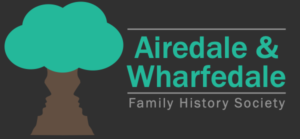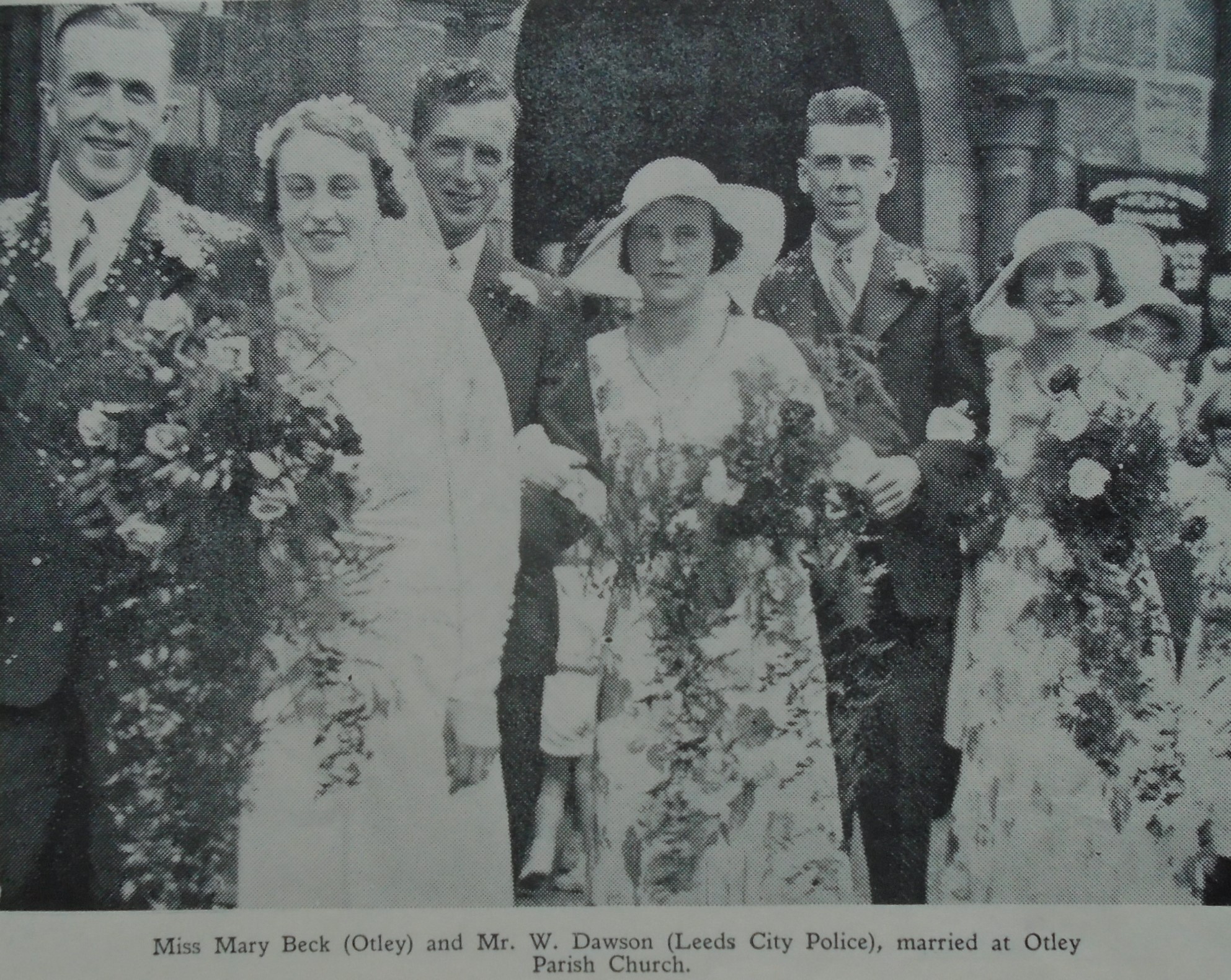





Airedale & Wharfedale Family History Society
Finding New Routes to Trace Your Old Roots
















Below is the introduction from the publication booklet, the inscriptions from which have now been uploaded to the AWFHS Research Database.
FOREWORD
The Wharfedale Family History Group originally transcribed the Addingham Wesleyan Chapel Memorial Inscriptions in 1981/1982 but did not publish them at that time. I have recorded the Addingham Wesleyan interment registers this year and as a result of the knowledge gained from that exercise have also upgraded the M.I. transcriptions up to the present time. The original transcripts have been re-worked to show the plot numbers and resultant locations with a little more accuracy. In this edited version, Verses… etc that have no genealogical value are omitted.
Brian Clayton
September 1996
HISTORY OF METHODISM IN ADDINGHAM
Notes prepared in 1986 by the late Mrs Kate Mason, Reynard Ing, Addingham Moorside.
Religious dissent in Addingham started in the mid seventeenth century with a small group of Quakers who met at Upper Gatecroft and at a meeting house at Farfield Hall, where they had a burial ground. It was however to be the followers of Wesley, and the Haworth parson, William Grimshaw, whose preaching inspired many local men such as Tom Lee and Tom Illingworth to follow their example.
Preaching on the Methodist principles started about 1744, and in 1748 a society of Methodists was started in the village. By 1788 the society was able to build a chapel. The society grew as the population expanded so that: by 1808 an enlargement was necessary. The same year Addingham became the head of a new circuit. The chapel was enlarged again in 1834, since when its appearance remained unaltered until its final closure in 1973, when the school, provided and managed by the Methodists, was converted into their chapel, and the former chapel was sold and converted into flats.
The burial ground was provided by George Oates Greenwood a local landowner, who lived at Netherwood House, just over the parish boundary in Ilkley. The Greenwood family Mausoleum stands in the centre of the burial ground. Mr W. Lemmon states that the earliest burial entered in the Register of Burials is not until 1844. *
Besides the Wesleyan Methodist society there was an Independent chapel, which seems to have had only a short life, and was probably Congregational in persuasion. The Primitive Methodists started preaching here about 1821. Their first chapel was above the Oddfellows Hall (now demolished) on Lodge Hill, but they held many open air meetings. In 1913 they were given a plot of land in Main Street. This chapel was closed in 1955) and later converted into the Village Hall. The Methodist Reform Chapel, Mount Hermon, was built in the 1860s and still has a faithful following. How far these other sects used the Wesleyan burial ground is not clear until further research is done on the Methodist records at Sheepscar in Leeds.
For a fuller account of the Wesleyan Methodists in Addingham reference should be made to ” Methodism in Addingham” by W. Lemmon.
* The first interment was that of Thomas Beck, Stonemason, in January 1844.



Members of the Wharfedale Family History Group transcribed the Memorial Inscriptions of St Peter’s Parish Church, Addingham in the summers of 1981 & 1982. These transcripts for the past fourteen years been retained in the Groups’ research records.
In preparing these transcripts for publication, for clarity and reduction in volume, I have edited the original transcripts and excluded lengthy verses which have no family history significance.
It should also be noted that I have introduced some abbreviations such as ILMO = In Loving memory of. IMO = In memory of, IR = In remembrance. IARO = In affectionate remembrance of, wdtl = Who departed this life, HLTBO = Here lies the body of , HLITBO = Here lies interred the body of .
Brian Clayton
Wharfedale Family History Group
December 1996
(Revised Print Oct 2005) – Uploaded to the AWFHS Research Database 2021 and the sketch maps have been added to this post.





By Stanley Merridew
Whilst visiting Silsden Library on my quest for War Memorials I came across a real treasure:
SILSDEN PRIMITIVE METHODISTS by W J Robson published in 1910
It gives a detailed history of the Primitive Methodism movement within the former Silsden Primitive Methodist Circuit. This included chapels at the following places:
Silsden, Addingham, Farnhill, Steeton, Cowling, Sutton in Craven, Eastburn & Glusburn
The main interest to those with Wharfedale ancestors is the Addingham Chapel. The author states that, as with most early Primitive Methodist communities, the early meetings would have been held in the open air, but very early on they used a room at the Crown Inn. Surprising, given their abhorrence of strong liquor!
The author suggests the last link with those early days was a Mrs Richardson who died 13th February 1909 in her 79th year. This could be Elllen Richardson born Addingham, shown in the 1901 census living at 4 Cross End with her husband William born Skyreholme. Previously I found her in the 1861 Census, still single, living with her parents, John & Rachel Wilkinson, at “Rookery” in Addingham. By 1871 her husband William was also there. Their marriage was not in the parish church and unfortunately the Methodist records for Addingham at this date have not survived. Ellen died as a result of a fall at home and is buried in Addingham churchyard. Mi?
Mary Wall, born 12 Nov 1804, the daughter of William and Grace Wall, was another early convert. According to the author, she was brought by her Uncle William Procter, who was a member of the Wesleyan movement. Mary died young, on the 23rd July 1828. Her burial is shown in the parish register on 24th July, age 24, living at Walmsley Bridge. Other early converts were Elizabeth Rooking who died in June 1832 aged just 24 and Ellen Booth who died in 1847 aged 17.
According to the Quarterly Meeting reports in 1830 that “Bros Gill, Page and Fletcher of Silsden and Kenyon, Robinson, Smith and Brayshaw of Addingham form a committee and do their best in getting a chapel at Addingham. In 1832 a Sunday school was started and services were at this time held at Addingham Low Mill.
There is no other mention of this until 1837 when it stated in the Circuit Report that congregation at Addingham had purchased a plot of land and intended to build a chapel. Then in 1838, “200 circulars are to be printed……..and Messrs Butcher and Fletcher follow these circulars to raise subscriptions for the chapel.” They must have succeeded as by 1839 the chapel was opened. However, there were several occasions when appeals were made far and wide to help maintain the building, collections at many of the local chapels and further afield. One request was to the Manchester District.
In 1844 the secretary was Jos. Harrison and the treasurer was J Lister with T Gelard as his assisitant. There is further mention of Thomas Gelard, “The former part of his life was spent wickedly in the Army abroad.” From 1839 until he died in 1848 he was the Chapel Keeper.
In 1893 the new trustees were J Newton, J Leadley ( Minister), A Gill, J Walmsley, GB Prior, FH Smith, D Cotton, J Roe, J Clennie, T Jackson, R Fletcher, T Fletcher, T Green, S Lund, B Binns. Many of these may have been circuit officials from Silsden as several of the names do not appear at a quick glance in the 1891 census for the village.
Around 1880 a Sale of Work was held, I assume to boost the chapel funds and Hebden Wall gave a calf for sale and a resident named Williamson gave a bag of soot and a bag of turnips. This could have been John Williamson of School Bridge Back Street as his occupation is shown as chimney sweep in the 1881 census.
There was a custom within the Methodist communities to provide the preachers with their meals as many had travelled long distances, probably of foot, there and back. The author mentions Mr Barber (possibly Samuel), farmer of Home House Farm carried out this function for many years. Later Nathan Smith (Main Street) formerly of Silsden, continued this until his death. Then Hannah Pickard, wife of Abel, opened her home to the preachers.
The author also mentions individuals and families who have held positions such as class leader, collectors for the missionary cause, stewards etc. These include: Barber, Brayshaw, Dunn, Ellis, Harkness, Harrison, Hebden, Moorhouse, Parkinson, Prior, Walmsley, West, Wynn. One former official, J Steele, went to Australia and died there.
Addingham produced several notable preachers who travelled the circuit. The author named the following: Flesher Bland, Mark Robinson (who later emigrated to America), Sarah Brayshaw, Ann Robinson, W Hebden, T Tattersall, J Richardson, A Myers, A Dunn, J Read, J Robinson, R Jarman.
The author gives Sarah Brayshaw special mention. She was born in Addingham 10th February 1808, became a preacher in 1831 and covered a wide area, taking in the Grassington, Skipton, Keighley, Bingley and Otley circuits, mainly on foot. She died 22nd January 1890. The author devoted over two pages to her, so if she is “one of yours” you are very fortunate.
The Prior family also get special mention. John Prior was awarded the sum of thirty guineas in 1798 by the Society for Encouragement of Arts, Manufactures and Commerce. He was the first to invent an escapement for watches. Later in 1811 his son George was awarded ten guineas for creating the striking mechanism on a clock. Both awards would have been small fortunes at that time. Evidently he was asked to add the striking mechanism to Keighley Parish Church for a fee. After fitting they failed to pay him, so he removed it until they settled. George had a jewellery and watchmaking business in Leeds and is buried at Woodhouse Moor. His gravestone states he was a native of Nesfield.,
One amusing tale recounts how Abe Steel, a trombone player at the chapel who had lost his front teeth, decided he would be able to play better with false teeth. So he made himself a set out of wood! However, not surprisingly, they failed to work.


By: Stanley Merridew
Addingham, along with most Wharfedale villages was visited by travelling Methodist preachers from the middle of the eighteenth century.
Grimshaw, Colbeck, Maskew and John Wesley
all preached in the village. One of
those converted at the time was Thomas Lee. Born in Silsden, he served an apprenticeship
in Addingham and became one of Wesley’s travelling band of preachers.